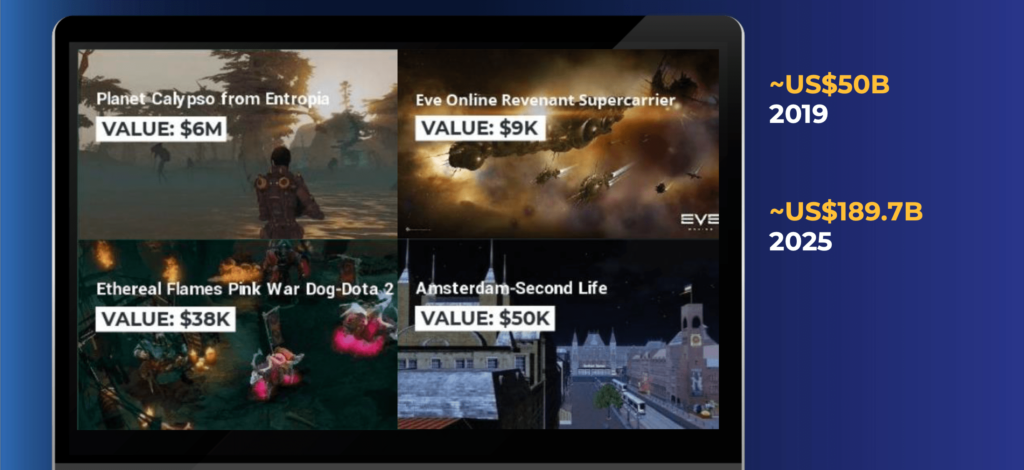Organised together with Pinnacle, the recent “Ready Player One?” webinar saw George Wong (Head of Growth for Singapore and Malaysia at The Sandbox) speak about the opportunities and utilities in the Metaverse.
As the Metaverse is a key component of Web3, here’s a summary of the key points raised in this webinar.
Growth of the Metaverse
One of the reasons why virtual worlds are expected to grow significantly is that our physical environments are shrinking due to population growth and increasing population density. This means that there will come a point in time when people need more space. Hence, virtual environments offer people the opportunity to have more “space”. This is why metaverses will become more relevant regardless of the form it takes–either Virtual Reality (VR) or Augmented Reality (AR).If fact, this was evident during the height of the COVID pandemic when lockdown/stay-home measures resulted in people venturing into games that had metaverse-like experiences, and becoming part of the virtual economy by purchasing items (i.e. digital assets) for their virtual identities or avatars. Moving forward, the usage of hardware (e.g. VR headsets and controllers, haptic suits, omnidirectional treadmills) enabling a more immersive VR experience may become more pervasive if costs can be brought down. Therefore, it will be some time before people are able to “exist” and interact within a virtual space despite many metaverses being VR-ready.

Understandably, there is a common misconception that metaverses are just games. However, when you consider that there are three billion casual gamers worldwide – the third largest demographic after the number of males and females – this represents a huge potential market size for metaverses.
With respect to market size, in-game spending is also a huge market. This comprises gamers buying cosmetics for their avatars, and purchasing in-game items to obtain an advantage in specific games despite these items having no real-world value. In fact, in-game purchases in traditional Web2 games totalled ~US$50B in 2019 and is expected to grow to ~US$189.7B by 2025.
The Metaverse and NFTs
In-game purchases are the business model of all free-to-play games. In other words, free-to-play games monetise virtual assets (essentially what NFTs are) which is also the method of monetisation for many NASDAQ-listed game companies.
NFTs represent ownership of intangible assets and are the primary catalyst driving the growth of metaverses. They are also a means of protecting digital assets/content from piracy as people can now prove ownership of digital assets/content in a court of law.
In contrast to current in-game assets which have no value outside the game, NFTs can be monetised. This means that beyond the revenue made from the initial sale of an NFT, the creator of the NFT can also earn royalties from any subsequent sale of the NFT.
Besides monetisation, another aspect of NFTs is that people tend to collect/buy things that represent them – similar to how people buy specific brands of watches, clothes or bags that they feel represent them in the real world.
All of the above validates how items in the metaverse actually do have value despite being intangible.
Open and Closed (Centrally Controlled) Metaverses
The two main categories of metaverses are open and closed – or centrally-controlled – metaverses.
One of the key differentiators of open and closed metaverses is that in closed metaverses, users must obtain “permission” to buy, build or do things. In contrast, users in open metaverses can buy or build anything themselves – which is where the current market is headed towards.
Other defining elements of open metaverses include…
- Avatars: A representation of an individual in the metaverse (similar to one’s profile on social media). Avatars are also an avenue for celebrities to monetise their image.
- Experience: The experience is how a metaverse connects with its users. It’s something that companies will have to be innovative in so that they can enable engagement within the metaverse. Some examples of such experiences include parkour/obstacle courses, fashion shows, adventure quests, skating, shooters, retro gaming, and world-building.
- Culture: Brands and experiences that metaverse users can connect with.
- Content: NFTs that can be monetised.
- The Blockchain: which enables all of the above.
Succeeding in the Metaverse
To be successful in the metaverse, companies will need to capitalise on user-generated content to amplify their brand communication strategy. However, any brand can be relevant in the metaverse if they experiment with it – which is currently the stage at which most brands are.
At this stage, it is important for brands to note that each metaverse has a different “angle”. Some are browser-based for the mass market, whilst others focus on user-generated content. Yet others focus on providing hyper-realistic VR experiences. Regardless of the differences between metaverses, good metaverses will have “no-code” tools to build assets in that metaverse. However, what all of these metaverses represent is a potential for innovation in the buying experience for physical products.
Last but not least, for any brand considering a presence in the metaverse, the following are five of the most important ingredients for success.
- Give value to fans and loyal users
- Reward users for their contributions
- Embrace NFT culture
- Put creativity first
Q&A Segment
How will the metaverse unfold and transform enterprises?
The metaverse is more of a necessity than an option, and the natural progression is for the market to expand into digital engagement – for which the metaverse can represent the next step.
Currently, the market conversation is still in the early stages, hence why companies are still hesitant about jumping into the metaverse. However, it is a good time to start experimenting so that they can be ready for a younger generation for whom NFTs will become the norm.
What do you feel are the current and potential challenges that creators and enterprises face when they integrate their businesses into the metaverse? And how can they overcome these challenges?
The primary challenge for enterprises is a lack of understanding about the metaverse at the senior management level.
The second challenge is regulation, compliance, and accounting. How do you value a virtual asset and account for it/record it in the books?
The third is skill. Building in the metaverse requires animators, as well as others who can build in a virtual, 3D environment. However, most companies currently do not have people with these skillsets. Hence, companies will need to rally and work towards solutions that overcome these challenges.
How do you generate revenue in the metaverse?
The first revenue generator is the sale of assets. These include lands, avatars, or NFT sales, and even the sales of digital wearables.
The next area of revenue is the sale of services. In Singapore’s context, there is currently an insufficient number of studios that can design and build for the metaverse.
Otherwise, avenues for generating revenue in open metaverses are quite varied.
How do brands connect the metaverse to real life? Can the metaverse drive real-life transactions for brands?
Despite the market not being ready for direct e-commerce in the metaverse yet, there is an example of the metaverse driving real-life transactions. An organisation involved in large music festivals is thinking of having a virtual twin of their festivals before the actual festival. This would give potential attendees an idea of what the festival would be like before they commit to buying tickets.
Essentially, the metaverse can be used to complement existing marketing campaigns.
What is the role of the Sandbox in building supportive communities around societal impact and conservation, mobilising purpose-led artists to showcase their art, music and creative representations – which can also be sold as NFTs – for game-changing causes that make a difference?
The Sandbox does a lot in the area of social impact, and the Game Maker Fund is used to support such initiatives.
One such initiative is a company that wants to do education in Africa. This company then reached out to other companies that already benefitted from the Game Maker Fund and collaborated with them on a programme to build studios and create jobs in Africa related to the metaverse.
The key when it comes to social initiatives is to build metaverse experiences that people will want to interact with.


